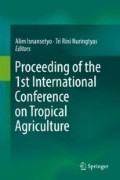Abstract
The objective of this article was to devise an approach that optimizes the participation of farmers and other stakeholders in (1) understanding the overall systems well enough to identify the problematic situations, the situations which participants considered as uncomfortable, and (2) developing a qualitative model as the basis to formulate the most feasible strategies for mitigating the identified problematic situation. A series of interviews and workshops involving 27 goat farmers who are members of Kelompok Tani Tunas Mukti in Kecamatan Gumelar, Banyumas, have been undertaken. Results of the CATWOE analysis showed that the basic problem of the smallholder goat farming was the real current income of the goat-farming activities that was still under the farmers’ expectation. From this a causal loop diagram (CLD) was assembled based on two main variables: farmers’ income and goat population. There were two types of archetypes identified within the CLD: limits to growth and shifting the burden. The use of CLD as the qualitative modeling provided depth and richness to the findings through the ability of the models to find the feedback loops and describe linkages among elements within the systems. The identified archetypes help the researchers and farmers to find reasonable strategy to overcome the problem of limited goat-farming income.
Access this chapter
Tax calculation will be finalised at checkout
Purchases are for personal use only
References
Setianto, N.A., et al.: Identifying archetypes of an enhanced system dynamics causal loop diagram in pursuit of strategies to improve smallholder beef farming in java. Indonesia. Syst. Res. Behav. Sci. 31, 642–654 (2014)
Overton, J.: Smallholders. SAGE Publications. http://sage-ereference.com/view/environment/n990.xml (2011) Accessed 15 November 2011
Snapp, S., Pound, B.: Agricultural Systems: Agroecology and Rural Innovation for Development. Academic Press, Burlington (2008)
Maani, K., Cavana, R.: System Thinking, System Dynamics, Managing Change and Complexity. Pearson Education, New Zealand, North Shore (2007)
Rodríguez-Ulloa, et al.: Soft system dynamics methodology in action: a study of the problem of citizen insecurity in an Argentinean Province. Syst. Pract. Action Res. 24, 275–323 (2011)
Jackson, M.C.: Systems Approaches to Management. Kluwer Academic Publishers, New York (2002)
Checkland, P., Pollster, J.: Learning for Action: A Short Definitive Account of Soft Systems Methodology and Its Use for Practitioners, Teachers and Students. Wiley, Chichester (2006)
Senge, P.M.: The Fifth Discipline: The Art and Practice of the Learning Organization. Doubleday, New York (2006)
Giller, K.E., et al.: Communicating complexity: integrated assessment of trade-offs concerning soil fertility management within African farming systems to support innovation and development. Agric. Syst. 104, 191–203 (2011)
Nelson, R., Consoli, D.: An evolutionary theory of household consumption behavior. J. Evol. Econ. 20, 665–687 (2010)
Giller, et al.: Conservation agriculture and smallholder farming in Africa: the heretics’ view. Field. Crops. Res. 114, 23–34 (2009)
Acknowledgments
This research was funded by the Ministry of Research, Technology, and Higher Education of the Republic of Indonesia within the scheme of Fundamental Research 2016.
Author information
Authors and Affiliations
Corresponding author
Editor information
Editors and Affiliations
Rights and permissions
Copyright information
© 2017 Springer International Publishing AG
About this paper
Cite this paper
Setianto, N.A., Hidayat, N.N. (2017). Using Causal Loop Diagram as a Qualitative Instrument to Model Smallholders: A Case Study of Goat Farming in Gumelar – Banyumas. In: Isnansetyo, A., Nuringtyas, T. (eds) Proceeding of the 1st International Conference on Tropical Agriculture. Springer, Cham. https://doi.org/10.1007/978-3-319-60363-6_42
Download citation
DOI: https://doi.org/10.1007/978-3-319-60363-6_42
Published:
Publisher Name: Springer, Cham
Print ISBN: 978-3-319-60362-9
Online ISBN: 978-3-319-60363-6
eBook Packages: Biomedical and Life SciencesBiomedical and Life Sciences (R0)

